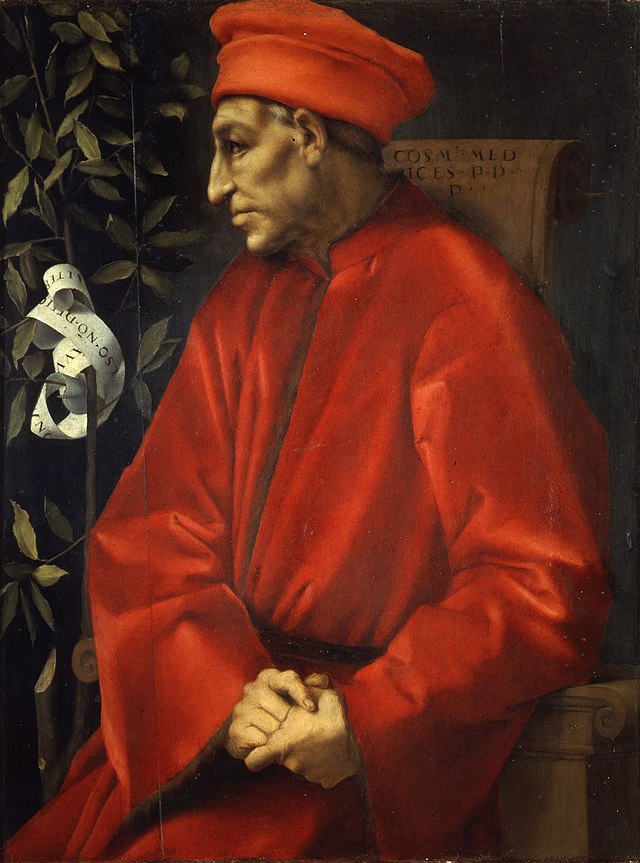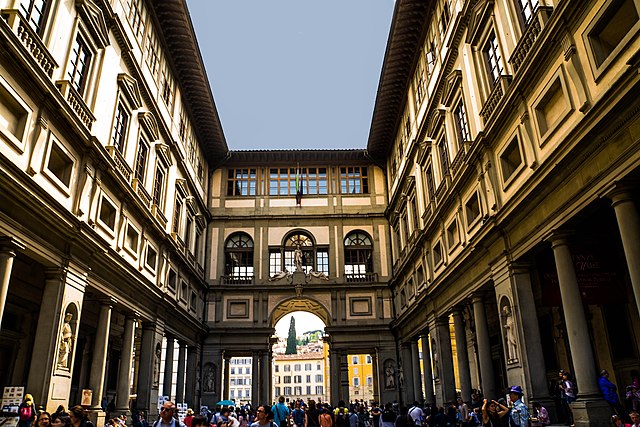It’s only a slight exaggeration to say that you could trip and fall in almost any direction in Florence and end up staring at a Medici landmark. The city was so reshaped by this famous family that it’s hard to imagine what a pre-Medici Florence might have looked like. Their importance to Florentine, Tuscan, and even Italian history cannot be overstated.
Here’s a brief overview of the historic highlights of the Medici family and a few of the many important Medici-related attractions in Florence.

Who’s Who: Medici Edition
Let’s get a couple of details sorted out first: It’s pronounced MEH-dee-chee, with the emphasis on the first syllable. The name comes from the Italian word for doctor, “medico,” in its plural form, although there’s some debate about whether the family were doctors before they rose to prominence as bankers in the 15th century.
Traveler’s tip: Medici isn’t the only influential figure in this idyllic Italian town. What to find out more about Michelangelo’s David? Check out our VIP Florence Duomo Tour, which comes with special early access to the halls of the Accademia Gallery to see David, as well as a skip-the-line ticket to the rooftop terraces of Santa Maria del Fiore.
Giovanni di Bicci de’ Medici
The Medici Bank was founded in 1397 by Giovanni di Bicci de’ Medici and it wasn’t long before the bank had elevated the family to the upper echelons of Florentine society. Giovanni established a precedent his heirs would (largely) follow: rather than set himself apart from the rest of Florence as some sort of royalty, which he could have easily done with his growing wealth, he endeavored to blend in. He declined government positions that were offered and dressed his family in everyday clothing, all while building wealth and stability for the family behind the scenes.
Cosimo de’ Medici
Giovanni’s son, Cosimo, took over running the bank from his father in 1420 and set another precedent for which the family will be forever known: he began using a substantial portion of the family wealth to patronize the arts. One of the most famous pieces of art that Cosimo paid for is Donatello’s David, a bronze free-standing sculpture now housed in the Bargello Museum. It was also during Cosimo’s reign that the Medici became the Vatican’s bankers, further cementing their wealth and status.

Lorenzo de’ Medici
The next notable Medici was Cosimo’s grandson, Lorenzo, who assumed the position at the head of the bank in 1469. Lorenzo is frequently known by the nickname, “Il Magnifico,” or “The Magnificent,” a moniker he apparently bestowed upon himself. Although Lorenzo is perhaps the best-known Medici among tourists (he’s the one we have to thank for so much artwork by Michelangelo, da Vinci, and Botticelli, after all), he wasn’t the savvy businessman his predecessors were. His oldest son, Piero, took the bank over after Lorenzo died in 1492, but Piero was exiled in 1494 and the bank quickly fell apart.
Medici Popes: Leo X, Clement VII, Pius IV, and Leo XI
The Medici returned to prominent status in Florence in 1512 when Cosimo I was named the first Grand Duke of Tuscany in 1569 by the pope. It’s during the 16th and early 17th centuries that the family also rose to power inside the Vatican—four became popes (Leo X, Clement VII, Pius IV, and Leo XI)—as well as French royalty (two of which became queens).
Anna Maria Luisa de’ Medici
The glittering dynasty came to an end in the 18th century when the last Medici, Anna Maria Luisa de’ Medici, died in 1743. Upon her death she bequeathed the vast majority of the family’s art, palaces, and other belongings to the Tuscan state—with the provision that nothing would ever leave Florence.
From the ambitious founding of a bank to Anna Maria Luisa’s death 346 years later, the Medici family left behind countless indelible marks on Florence. There are the family’s former homes and offices, the church where many Medici are buried, and examples throughout the city of Medici-funded artwork—particularly due to the significant role Lorenzo’s art patronage played in the Italian Renaissance.

This is by no means an exhaustive list of Medici attractions in Florence, but it’s a starting point for anyone trying to understand the cultural importance of the most famous family in Florentine history.
Where the Medici Family Lived
Palazzo Medici-Riccardi
The first palatial Medici home was built in the mid-1400s for Cosimo. It’s a three-story structure with increasingly refined stonework on each higher floor. Michelangelo lived in this palace as a young man.
It’s now called the Palazzo Medici-Riccardi for the family that bought it from the Medici in 1659. Today, the palace is home to both Florence’s city government offices and a museum—which includes the Medici family’s private gardens and chapel.

Palazzo Vecchio
The Palazzo Vecchio was originally called the Palazzo della Signoria when it was begun in the late 13th century, and it served as a town hall until Cosimo I decided to move in in 1540. Cosimo I gave it its current name, which means “Old Palace,” when he moved out less than a decade later.
Today, though it once again serves as town hall, the palace is also a museum with several sections. One of the main attractions is the Salone dei Cinquecento, or Hall of the 500, which has enormous frescoes and a beautiful paneled ceiling. Art by Michelangelo and Donatello is everywhere—but the statue of David at the front door is a replica.

Palazzo Pitti & Boboli Gardens
When Cosimo I moved out of the Palazzo della Signoria, it was for fancier digs across the river in the Palazzo Pitti. This enormous palace was built in the mid-15th century for another Florentine banker named Pitti and it became the Medici home in 1549. The palace was also home to two ruling families after the Medici. The Pitti contains five different museums today, including the Palatine Gallery, where part of the Medici family’s incredible collection of artwork is on display.
The Medici purchased some land behind the palace as well and Cosimo I’s wife, Eleonora, had it transformed into a spectacular garden space. The Boboli Gardens cover roughly 11 acres, making them the biggest green space in the city and the garden design served as the inspiration for palace gardens elsewhere in Europe. There are grottoes, fountains, statues, and even an Ancient Egyptian obelisk.

Where the Medici Family Worked
Uffizi Gallery
While it’s a rare visitor in Florence who hasn’t heard of the city’s most famous art museum, not everyone knows that the building itself used to be where the Medici family did business. The Uffizi Gallery takes its name from the Italian word for “offices”—uffizi.
Cosimo I commissioned the building of the Uffizi to house the family’s business enterprises next door to the former Medici palace, the Palazzo della Signoria (now the Palazzo Vecchio). When the last of the Medici family died, the enormous structure (which already housed quite a bit of artwork) was filled with more of the family’s extensive art collection. It was opened to the public as a museum in 1765.
The Uffizi art collection is one of the most remarkable in the world, especially Italian Renaissance art. Some of the most famous pieces at the Uffizi are Michelangelo’s Doni Tondo, da Vinci’s The Annunciation and Adoration of the Magi, Raphael’s Madonna of the Goldfinch, Titian’s Venus of Urbino, Caravaggio’s Bacchus and Medusa, Artemisia Gentileschi’s Judith Beheading Holofernes, and Botticelli’s Primavera and The Birth of Venus.
Insider’s Tip: Lines to get into the Uffizi can be long, especially during high season. If you want to see all the highlights with a knowledgeable guide, sign up for our Florence in a Day Tour, which will let see this beautiful city and all that it has to offer.

When the Medici Family Died
Medici Chapels
There are dozens of famous tombs in Florence, but to see most of the Medici in one place you need to visit the Basilica di San Lorenzo. There are two chapels there, called the Medici Chapels, which are the final resting places for several members of the family.
The first, the New Sacristy, has two enormous sarcophagi (with sculptures by Michelangelo) for two lesser-known Medici—Giuliano di Lorenzo and Lorenzo di Piero. Two more tombs, for Lorenzo “Il Magnifico” and his brother Giuliano, were never built. Their bodies lie, instead, under the altar near the entry. The founder of the Medici dynasty, Giovanni di Bicci de’ Medici, is also buried underfoot in the New Sacristy—in the center of the room.
There are tombs and funerary monuments to Medici Grand Dukes in the Chapel of the Princes, the second Medici Chapel, though six tombs are empty (the remains are actually in the basilica’s crypt). This octagonal chapel is lined with colorful slabs of marble and stone, topped by a dome that, from the exterior, resembles the one on the city’s cathedral. Construction started in the early 17th century but work continued through the mid-19th century.
There are also some 50 members of the Medici family in the basilica’s crypt, including Cosimo the Elder, who asked that his friend, Donatello, be buried nearby.

Other Major Sights in Florence with Ties to the Medici
As mentioned, evidence of the influence of the Medici family in Florence is all over the city. Here, in no particular order, are a few other places that wouldn’t be the attractions they are were it not for the Medici family.
Accademia Museum
Michelangelo’s stunning David originally stood at the entrance of the Palazzo Vecchio, a former Medici home, until it was moved to the purpose-built Galleria dell’Accademia in 1873 to protect it from further damage from the elements. The museum also has a handful of other Michelangelo sculptures, the original plaster for Giambologna’s Rape of the Sabine Women, a small collection of paintings, and several historical musical instruments.
Vasari Corridor
When the Medici family moved to the Palazzo Pitti across the Arno, their offices were still in the Uffizi. Walking to work, winding their way through filthy streets, wasn’t ideal. So, Cosimo I commissioned Giorgio Vasari to build what’s known as the Vasari Corridor—a raised path for the family’s commute to and from work. Today, it’s open only with guided tours, its walls lined with artwork.

Biblioteca Laurenziana
Otherwise known as the Biblioteca Medicea Laurenziana, this library inside the Basilica di San Lorenzo has roughly 11,000 ancient and historic manuscripts in its collection—the core of which came from the Medici’s private library. It’s not a lending library, but it still draws visitors for its Michelangelo-designed vestibule and reading room.
Bargello Museum
The Bargello is to sculpture what the Uffizi is to paintings, and one of its most important pieces is the bronze David that Cosimo commissioned in the mid-1400s. Other sculptures in the museum’s impressive collection include a Bacchus by Michelangelo, a bronze bust of Cosimo I by Cellini, and two contest entries for the commission of the “Gates of Paradise” doors on the Duomo’s Baptistery.

Skip the long lines to climb to the top of the Duomo and slip into the Accademia Gallery before the crowds arrive to see Michelangelo’s David with our VIP Florence Duomo Tour! You’ll not only receive early access to the Accademia and skip the line at Florence’s majestic cathedral but learn many more insights into the influential Medici family.

